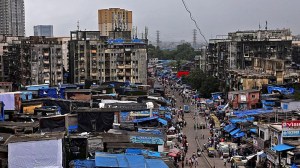Status & significance of massive anti-Naxal op in Telangana-Chhattisgarh border
Hundreds of Maoists, including top leaders, are said to be holed up in the Karregutta hills on the border of Chhattisgarh and Telangana. Defeating them would be a major milestone in the government’s push to wipe out Naxalism in Chhattisgarh
 The terrain provides a major challenge for security forces. (Express Photo)
The terrain provides a major challenge for security forces. (Express Photo)Some 24,000 security personnel have surrounded the Karregutta hills along the Chhattisgarh-Telangana border for what authorities say is a “decisive” operation to “end the menace of Left-Wing Extremism” in Bastar.
Key Maoist leaders are said to be holed up in these hills, which are guarded by Battalion 1, the strongest military formation of the People’s Liberation Guerilla Army (PLGA), the armed wing of the banned Communist Party of India (Maoist).
The operation, named “Mission Sankalp”, began on April 21. “Mission Sankalp will bring an end to the six-decade long menace of Left-Wing Extremism in Bastar and other parts of the country. The leadership is committed to the cause and the troops are highly motivated for the mission,” said Sundarraj P, Inspector General of Police for the Bastar Range in Chhattisgarh.
Battalion 1 has been involved in the killings of at least 155 security personnel since 2010, including the massacre of 76 Central Reserve Police Force (CRPF) jawans in Tadmetla, Sukma in 2010. Defeating them will thus be a major milestone in the government’s push to end Naxalism in Chhattisgarh, for which Union Home Minister Amit Shah set a March 2026 deadline.
The challenge
A senior official said that “the strategic location, tough hill terrain, and a long stretch of interstate border” gives the mission “specific time, space and location dynamics”, different from other anti-Naxal operations which normally last only a couple of weeks.
The Karregutta hills run for almost 60 km along Chhattisgarh-Telangana border. They have particularly steep slopes which pose difficulties in accessing the heights on both the Chhattisgarh and Telangana sides.
For Maoists, the natural barriers and resources in the hills, as well as the security vacuum along the interstate border makes the Karregutta hills a perfect hideout.
“Karregutta hills have been identified by the naxal cadres as safe hideouts due to its tough terrain, rocky hills, numerous caves and undulating surface. The prevailing climatic condition in the area is a mixture of hot humid summer and thunderstorms rainfall,” said a senior official monitoring the operations.
Battalion 1 occupies dominant positions on the top of the hills, former Chhattisgarh DGP R K Vij told The Indian Express. “They would have planted Improvised Explosive Device (IEDs) on the perimeter, and likely have snipers as well. The forces have to be tactful in their approach,” he said.
Security forces believe the Battalion 1 is guarding top Maoist leaders such as Central Committee (CC) members Pulluri Prasad Rao alias Chandranna and Sujata; PLGA chief Barse Deva; Madvi Hidma, the commander-in-chief for for military ops in South Bastar; Sannu, a Dandakaranya Special Zonal Committee member; and Damodar from the Telangana State Committee.
The progress so far
Thus far, “less than 50% of the task is done”, said the security official. Three Maoists from Battalion 1 have been gunned down, while three jawans escaped with minor injuries in separate IED blasts. But IG Sundarraj, earlier this week, claimed that security forces have “inflicted heavy casualties”.
Apart from the unfavourable terrain, the scorching summer heat appears to be another significant challenge, with an official confirming that dehydration is something that the forces have to grapple with. The Naxals have a steady source of water in the many fresh water springs on the hills.
But the official added that security forces had one big advantage: the lack of a civilian population in the hills. “There is no chance of civilians getting hurt. This is a big advantage the forces have,” this official said.
According to IG Sundarraj, “The outcome of anti-Naxal operations is not only about the number of Naxals killed or weapons recovered. Clearing the area from the captivity of a banned Maoist outfit is also an important objective.”
“Maoists had the audacity to plant multiple IEDs along the hill range, rivers and valleys in the sacred land of Bastar and warn the native population not to venture into their own land. One of the IEDs planted by Maoists near the hills led to the death of an innocent tribal woman Sushila Sodi while she was grazing cattle on March 30,” he said.
The political reaction
Telangana Chief Minister and Congress leader A Revanth Reddy has said that his government looks at “Naxalism only from a social perspective and does not consider it a law-and-order issue”.
Former Telangana CM and Bharat Rashtra Samithi (BRS) president K Chandrashekar Rao (KCR) urged the Centre to “stop” the anti-Naxal operation in Chhattisgarh immediately and “hold talks with Naxals like it is done in a democracy”.
An umbrella group of several tribal rights organisations wrote to President Droupadi Murmu requesting a cease-fire, and dialogue with Maoists to stop the violence.
Politicians in Chhattisgarh, however, have backed Mission Sankalp, questioning the credibility of the activists questioning the operation.
Chhattisgarh Home Minister Vijay Sharma said: “Those who do not believe in the constitution, use guns and want to come to power from the barrel of a gun… how can they [the activists] talk about them and mention the constitution while doing so?”


- 01
- 02
- 03
- 04
- 05



































